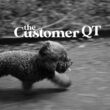In life and loyalty, feelings are tough.
I was doing some post-holiday shopping and saw this t-shirt online. It got me thinking about John T. Molloy.
Back in 1975 Mr. Molloy wrote Dress for Success. It was a big best-seller. The first-of-its-kind book about the effects a person’s wardrobe had on success. In their business life and in their personal life. Sure, there were lots of fashion magazines, but those addressed aesthetics. The book demonstrated how you dressed acted as a subconscious cue when it came to establishing authority in social and business relationships. It popularized the phrase “power dressing.” Because how you dressed made a non-verbal statement about who you were as regards other people’s expectations. Cool, huh?
Molloy’s insights were based on research which, for two obvious reasons, has great appeal to us. First, because it was based on research, and second because that research was psychological in nature. It measured how people felt, rather than what they just said. Which coincidently, is the same thing you need to do to figure out why consumers are loyal to brands. And also the reason why that approach predicts how consumers will behave in the marketplace. Equally cool!
Not-so-coincidently, we introduced the 2023 Customer Loyalty Engagement Index last week. It’s the 26thannual survey, so kind of a little-black-dress of research. You know, a classic. We use a combination of psychological inquiry and higher-order statistics to identify brand loyalty levels as well as unarticulated expectations consumers hold for the (mostly-emotional) behavioral drivers that turn consumers into loyal customers. We use those analyses to identify, if I may amend one of Mr. Molloy’s terms, “loyalty power brands.”
And even though our approach to loyalty has been independently validated and correlates very highly with consumer behavior (0.80+) the t-shirt got me thinking. You don’t really need to be a researcher to understand that, without saying a word, clothes do a lot of talking for us. Call it “self-expression” or “individuality” or “personal style” or “a look,” but it’s why the Little Black Dress, a white dress shirt, a blue blazer, jeans, and a basic cardigan are considered timeless classics.
And then there’s the ubiquitous t-shirt. It’s an evergreen fashion icon if there ever was one. T-shirts have become wardrobe essentials. Wear one and you can look casual. Or elegant. Stylish or sexy. Also, not-so-coincidently, some of the best-selling t-shirts of all time laude actual brands consumers have opted to wear to express engagement, identify, and loyalty. Chart-topping tees include:
- Kiss Me, I’m Irish
- I ♡ NY
- Keep Calm, And Carry On
- Rolling Stones
- Superman
- ARMY
- Che Guevara
- Mickey Mouse
- Hard Rock Café
- Harley Davidson
- I’m With Stupid
- Vote For Pedro
- Ghostbusters
- Coors
- Einstein
- Batman
- NASA
- Favorite Sports Teams
T-shirts with a quotation, or an image, or a quotation and an image can articulate how you feel and what you feel most strongly about. It gives people and positions a voice. And, boy, some of them speak volumes – about you, your interests, your cultural choices or your tribal affiliations. The same way loyalty speaks loud and clear about how you feel about brands, but without having to actually articulate those feelings. Because in life and loyalty, feelings are tough. Putting on a t-shirt? Not so much! And they’re leading-indicators – loyalty and your t-shirt choice – of brand emotional engagement and behavior and, ultimately, where applicable, brand profitability. Indicators of, not what people did the last time, but what they’re going to do the next time, which is an importance nuance.
T-shirts with quotes or images (or both) can be a fashion ecosystem of lifestyle and loyalty. And an inexpensive way to brand yourself or boost a brand. A Walmart message t-shirt can be purchased for as little as $15.99. And while money may not be able to buy happiness, it can get you a Philipp Plein Scarface T-shirt for $600. Or a Gucci tee for $1,000. Or if you’re really feeling flush, a Tom Ford tee for $1,700, albeit Italian-made in cashmere. How much consumers are willing to spring for a tee depends on the materials of course, but mostly the degree of emotional engagement a consumer holds for the statement or icon or brand and what it “says.”
The modern version of the t-shirt was first manufactured in 1898, and it took about 100 years or so to become a social media platform, turning consumers into billboards. You really have to be loyal to do that and pay for the privilege! T-shirts have gone corporate what with distribution coordinated with movie openings or concert tours. And they ain’t cheap! And, not for nothing, but “vintage” has taken on a new meaning when it comes to t-shirts. Released yesterday, here today, and unavailable tomorrow. I wonder what Mr. Molloy would say about that kind of power?
I’ve said it before, loyalty – and the values that create, craft, drive, and reinforce loyalty – are mostly-emotional and harbingers of what people expect. And, ultimately, what they’re going to do. Words (and/or images) on a t-shirt can create awareness and can bring about social and cultural and personal change. And, for brands – engagement, loyalty and sales. OK, not so much with “I’m With Stupid” tee, but still.
Oh, and the t-shirt that got me thinking about all this? It was black. With white type and read, “Don’t Look Back. You’re Not Going That Way.”
Because, as it turns out, when it comes to loyalty, neither are your customers.
Photo by Yuliya Shik on Unsplash













